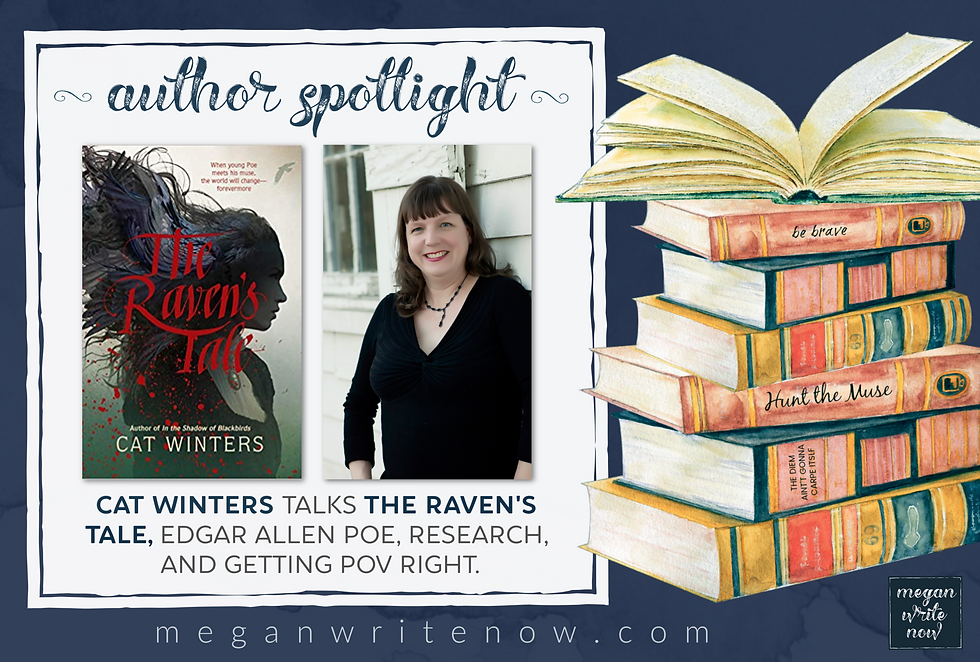Author Spotlight: Cat Winters talks The Raven's Tale
- Megan LaCroix

- May 15, 2019
- 5 min read

The amazing Cat Winters is on today's blog! Cat is a critically acclaimed, award-winning author who been named a Morris Award finalist, a Bram Stoker Award nominee, and an Oregon Spirit Book Award winner. She is the author of five young adult novels which have appeared on Kirkus, School Library Journal, and Booklist best-of-the-year lists, as well as numerous state lists.
Cat's latest YA novel, The Raven's Tale, is available now from Harry N. Abrams. Check out the synopsis below!


Seventeen-year-old Edgar Poe counts down the days until he can escape his foster family―the wealthy Allans of Richmond, Virginia. He hungers for his upcoming life as a student at the prestigious new university, almost as much as he longs to marry his beloved Elmira Royster.
However, on the brink of his departure, all his plans go awry when a macabre Muse named Lenore appears to him.
Muses are frightful creatures that lead Artists down a path of ruin and disgrace, and no respectable person could possibly understand or accept them. But Lenore steps out of the shadows with one request: "Let them see me!"
And now, here's my chat with Cat!
Hi, Cat! Welcome and congrats on The Raven's Tale. Can you tell us a little about the story and what inspired it?
Thank you so much for hosting me, Megan! I’m happy to be here.
The Raven’s Tale is a coming-of-age story that sets out to show how an unknown teenage boy from Richmond, VA, turned into legendary author Edgar Allan Poe. After writing six other historical novels that involved only fictional characters, I wanted to challenge myself by taking on a real-life historical figure as the subject of my next book. I picked Poe, because his dark and haunting stories and poems have intrigued me ever since I was twelve years old, but I’d never learned all that much about him as a person. I decided to set my novel during the pivotal year of 1826, when seventeen-year-old Edgar was forced to choose between living the life of a respectable Southern businessman and following his muse. His muse, in fact, appears in the book as a living and breathing creature.
I’m so intrigued by Lenore’s role as The Muse. What was your favorite thing when it came to writing her POV?

I actually wrote three different drafts of The Raven’s Tale before I finally figured out how to write Lenore. Once I realized she was the embodiment of Edgar Allan Poe’s macabre works—and that she should look and behave like the embodiment of his works—I let loose and created this monstrous, emotional, eager-to-be-seen creature who’s part chilling young woman, part “ghastly grim and ancient raven” (to quote Poe’s iconic poem “The Raven”). Through Lenore’s character, I literally allowed Poe’s imagination to run wild in the novel. That wildness and passion for poetry and weirdness were so much fun to write.
I love the secret history aspect of The Raven’s Tale. What was your research process like, and how much of it were you able to incorporate into the book?
I read as many of Poe’s works as I could, and I pored over biographies, letters, and historical records related to Poe’s younger years. I also spent time in Richmond, VA, the city where Poe lived most of his teenage years, and the University of Virginia in Charlottesville, where he attended college at the age of seventeen. Each page of the novel involves details I soaked up when researching Poe’s youth, and I populated the book with his real-life friends, family members, and acquaintances. I found ways to incorporate most of my research into the pages of the novel, and what didn’t make it into the story showed up in notes at the end.
What part of the writing process do you find most challenging and how do you tackle it?
I love revising, and because I’ve worked with fabulous editors like Maggie Lehrman of Abrams, I’ve come to think of the revision process as the most important and fulfilling part of writing. When I’m plodding along with my first drafts, however, I usually struggle a bit and wish I could simply fast-forward to revisions.
What really helps is knowing something about how the book ends—where I’m going with the story. If I think of everything I’m writing as building up to that beautiful, life-changing ending, it’s easier to map out all the challenges and successes my main character needs to encounter before arriving at that destination. I also find it helpful to create a plot-propelling relationship—a close and complicated bond between two characters that charges the story with lovely jolts of electricity, piques my interest, and moves the book forward. In The Raven’s Tale, the plot-propelling relationship was the one between Poe and Lenore. I wanted to do everything in my power to get those two characters in scenes together, even though obstacles and other characters—and sometimes even their own personalities—tended to drive them apart, and that helped me get the first draft down on the page.
I'm a firm believer in the idea that every story teaches the writer something new, so what did writing The Raven’s Tale teach you?
It taught me to greatly respect anyone who writes about real people! Whether an author writes nonfiction or biographical fiction, the research is intense and often expensive, the pay isn’t always great, and they put themselves at great risk of disappointing, and even angering, anyone who feels an affinity to their chosen subject. I can’t say that I would write a book like this again, but I certainly appreciate anyone who takes on this type of work for our entertainment and enlightenment.
What are you reading, or otherwise currently infatuated with?
I’m on a quest to learn more about pioneering women in movie history, simply because the subject matter interests me and inspires me as a female artist. It started with books I read for a nonfiction project I’d considered writing, and just recently I read and loved Mallory O’Meara’s The Lady from the Black Lagoon: Hollywood Monsters and the Lost Legacy of Milicent Patrick. I have Ink & Paint: The Women of Walt Disney’s Animation, by Mindy Johnson, on hold at my local library and can’t wait to read it next. In the realm of fiction, I recently read His Hideous Heart: 13 of Edgar Allan Poe’s Most Unsettling Tales Reimagined, edited by Dahlia Adler. The anthology debuts September, 10, 2019, and I highly recommend it.
And finally, what’s the most important lesson you’ve learned (so far) in your publishing career?
Take care of yourself, no matter what stage you’re at in your writing. We writers often let our writing careers control us completely, and we leave little time for our health and happiness, especially since we’re often working other jobs or writing multiple books at the same time. I’ve been contracted with publishers since 2011, and I’d say I’m happiest as a writer—and I’m a better writer—when I allow myself moments to step away from my work to breathe, read, spend time with people I love, and refill my creative well. In recent years, I often felt like I didn’t have any time to rest from my work, and as a result, I suffered from burnout and anxiety. But now I’m doing everything in my power to ensure I get the chance to be a human being, not just a writing machine.

Many thanks go out to Cat for taking the time to tell us more about The Rave's Tale! Be to sure to add this spectacular Edgar Allen Poe YA fantasy to your Goodreads list, or (better yet!) order your copy (WRITE) NOW from retail sites like Amazon, and Barnes & Noble, or request it at your library, or local independent bookstore!
For more information, follow Cat on Twitter, and visit her author website at catwinters.com.
And, as always,



.png)









































Comments